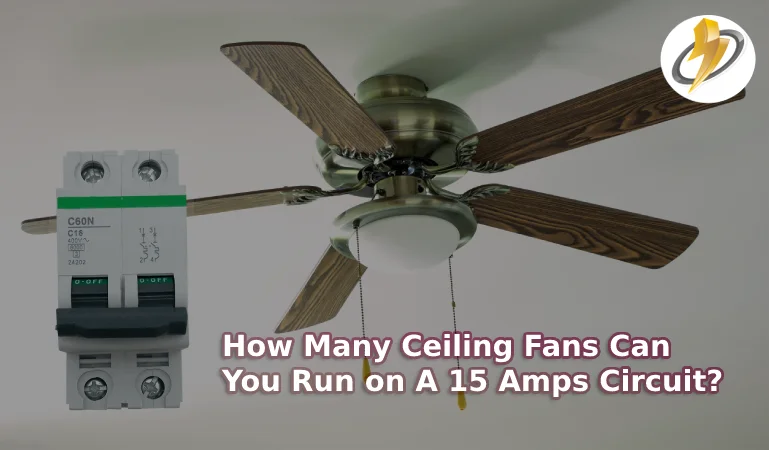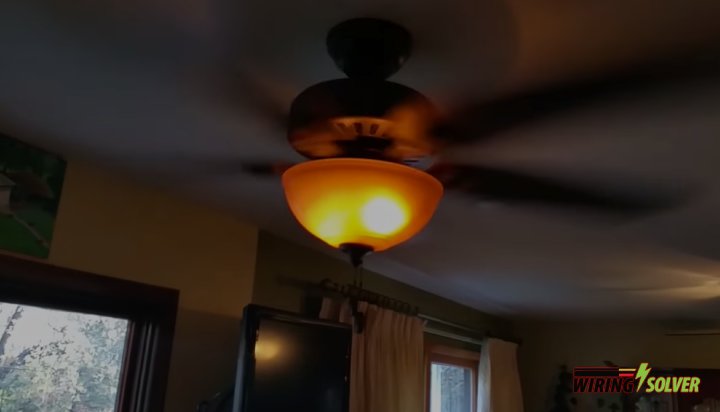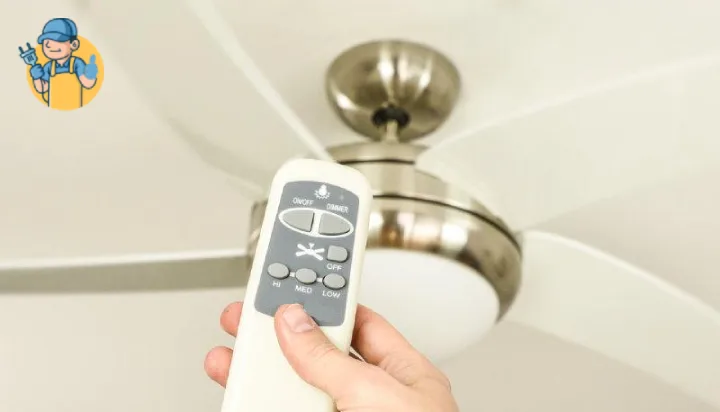Hunter ceiling fans have quite a reputation among ceiling fans. They are of great quality and reliable. However, like all other electrical equipment and appliances, Hunter ceiling fans also may run into several issues.
So, what causes can be behind a Hunter ceiling fan not working?
The issue could be with the circuitry. Such as a tripped breaker, faulty wiring, broken switch, etc. Or it could be due to the remote not working. And finally, it could be an issue with the fan itself.
This article will go through all the necessary steps needed to diagnose a malfunctioning Hunter ceiling fan and how to fix the issue.
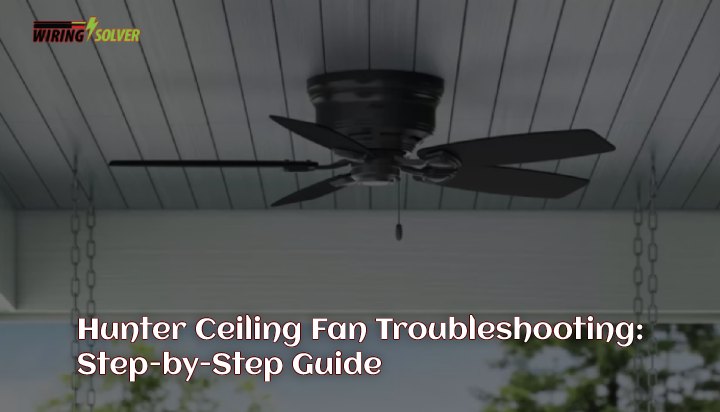
What Can Cause a Hunter Ceiling Fan to Malfunction?
There is a magnitude of reasons that could cause a Hunter ceiling fan to not work, ranging from circuit issues to a malfunctioning fan. I will Explore some of these possibilities now.
Circuit Issues:
1. Faulty Circuitry:
A common issue regarding a Hunter ceiling fan not working is faulty wiring.
If the wiring in the circuit was not made secure during installation, with time the wires could become distant from the terminals or connections, causing the ceiling fan to not work.
2. Tripped Breaker:
Make sure that the circuit breaker is not tripped. Properly check on which circuit the ceiling fan is installed on.
Then observe the main panel, and whether the breaker for that circuit has been tripped or not.
It could also be a GFCI outlet somewhere on the circuit that could also prevent a fan from working.
If you have any GFCI outlets installed on the same circuit, make sure that they are not tripped.
3. Broken Switch:
The damaged or broken switch could also hamper the flow of electricity. It is necessary to make sure that the switch is working as intended.
Oftentimes, a cheap or low-quality switch is the main culprit behind electrical appliances malfunctioning.
Remote Malfunctions:
1. Drained Batteries:
The reason behind a Hunter fan remote not working could be empty or drained batteries. Make sure that the remote batteries have enough charge to make the remote function.
2. Unpaired Remote:
Some Hunter ceiling fans need to be paired with the remote to work as intended.
So, it is crucial to make sure that both the fan and the remote control are paired with one another.
Different fans have different remotes and follow different methods to pair the fan. Make sure you follow the appropriate instructions to pair the fan.
3. Malfunctioning Receiver:
Sometimes the issue could be with the receiver box installed within the fan itself. But before you tinker with the receiver, make sure to disconnect the ceiling fan from any power supply.
Ceiling Fan Issues:
1. Physical Obstruction to Fan Blades:
Carefully inspect whether there is any sort of item or object that could obstruct the fan blades and prevent them from spinning.
If so, remove it. Often times something can get lodged between the blades and the body of the fan, and prevent it from spinning.
2. Motor Issues:
Sometimes, a ceiling fan’s motor can also burn out and stop working completely. In such a scenario, it is necessary to get a replacement.
As burnt-out motors are really hard to salvage. But this is a very rare case and the last resort to troubleshooting your fan.
Properly make sure that there are no other issues before you come to this conclusion.
How to Troubleshoot a Hunter Ceiling Fan?
The steps are quite simple to troubleshoot a Hunter ceiling fan. But the solutions may vary based on the issue. Let’s explore some of these fixes.
If the issue is with the circuitry, here are the steps on how you should proceed with fixing it.
Steps to Troubleshoot Issues Regarding the Circuit:
- Make sure that the switch is turned on and the circuit breaker is not tripped.
- Acquire a voltage tester, a non-contact voltage tester is recommended. And make sure that there is voltage in the positive terminal of the ceiling fan.
- If there is an absence of voltage, there is an issue with the circuit.
- Check whether there is voltage in the switch.
- If the circuit breaker is not tripped and the switch does not have voltage, there is either an issue with the switch or the wiring.
- Check if the wiring is okay.
- If so, replace the switch.
- Otherwise, it may be necessary to rewire the circuit.
But if the circuits are working as intended and no issue is found, one should move on to checking the remote. The steps to troubleshoot a Hunter ceiling fan remote are as follows.
Fixing the Hunter Fan Remote:
- Make sure that the batteries have enough charge to function.
- Replace the batteries if needed.
- Make sure that the ceiling fan is paired to the remote. As each fan model and each remote has a different method of pairing, it is suggested that you follow the manual for your specific fan model.
- If not, pair them. And that should solve any issue regarding a Hunter fan remote.
And finally, I will tackle the issue regarding the fan itself. But before you proceed to troubleshoot the fan, make sure that the circuitry and the remote are functioning properly.
Troubleshooting a Hunter Ceiling Fan:
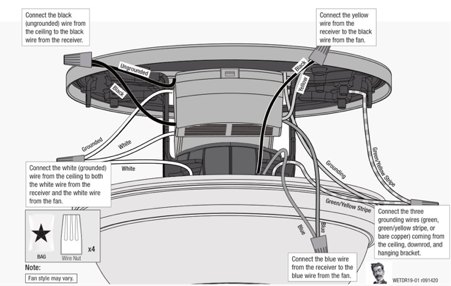
- Make sure that the motor reversing switch is not stuck midway.
- Turn off the power from your circuit breaker.
- Make sure that there is no voltage using a voltage tester.
- Loosen the canopy so that you have access to the wires.
- Different fans have different wiring diagrams. These diagrams can be found in the user manual for the said fan model. One example of such a diagram has been provided above (Fig 1).
- Make sure that the wire connections of your ceiling fan match the diagram in the manual.
- If not, rewire to fix the mistake.
- If the issue persists, there is a possibility that it’s an issue with the motor. Although rare, in such a case, it would need to be replaced.
These are some of the fixes you may implement if your Hunter ceiling fan stops working. Hopefully, one of these methods will get your ceiling fan working properly again.
Summary
Throughout this article, I have mentioned a list of possible causes behind a Hunter ceiling fan not working. And have also provided a step-by-step guide on how to fix the ceiling fan.
However, if you cannot pinpoint the issue, do not hesitate to contact a professional. As there could be several underlying issues that may be hard to identify without any professional help.

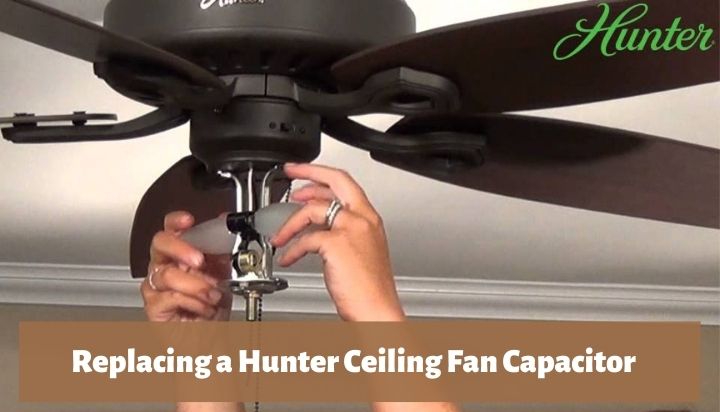
![Why Is My Ceiling Fan Not Responding To Remote? [Solved]](https://wiringsolver.com/wp-content/uploads/2023/03/Why-Is-My-Ceiling-Fan-Not-Responding-To-Remote-Solved.jpeg)
![How To Wire A Ceiling Fan With 2 Switches? [Full Guide]](https://wiringsolver.com/wp-content/uploads/2021/10/How-To-Wire-A-Ceiling-Fan-With-2-Switches.webp)
